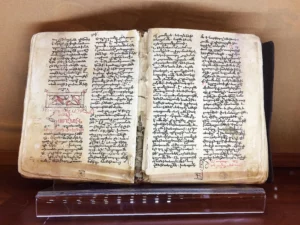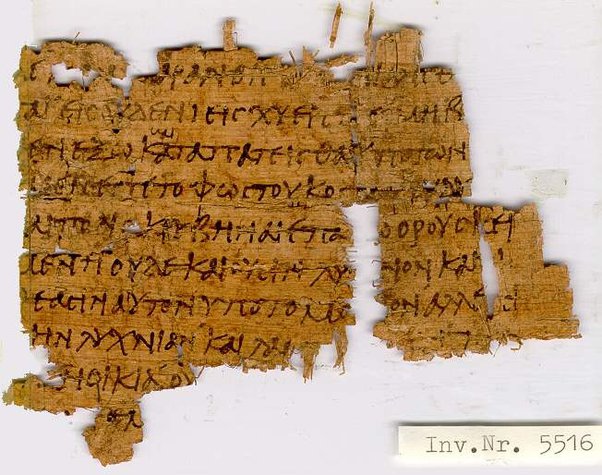Translation, Transcriptions, and Time

The following is edited an adapted essay from Rev. Frederick Henry Scrivener, ‘Six Lectures on the Text of The New Testament’ published in 1875.
The writings of ancient texts were published to the world at various times mostly during the latter part of the first century of the Christian era. Most of the early copies we have were found centuries later in Egypt where the climate was suitable for preservation. The art of printing was first practiced in some German city in the middle of the fifteenth century: the first fruit of typography, the beautiful Latin Bible known as Cardinal Mazarin’s, of which we have a copy in the British Museum, appeared at Mentz scarcely before A.D. 1455. During that long period of fourteen hundred years, through the fading light of the decline of ancient literature, through the deep gloom of the middle ages, even till the dawn of better days had almost brightened into the morning sunshine of the revival of learning (thanks to the Muslim world), ancient texts were preserved and its study kept alive in the same way as were the classical writings of Greece and Rome, by means of manuscript copies made from time to time as occasion required, some times by private students, more often by professional scribes called calligraphers or fair-hand writers, who were chiefly though by no means exclusively members of religious orders, priests or monks, carrying on their honourable and most useful occupation in the scriptorium or writing-chamber of their convents.
And here I must say in passing, that whensoever the mind shall attempt to strike a balance between the good and ill effects of the monastic system during the thousand years and more which separated the Council of Nice from the day-spring of the Reformation, this one great service rendered by ecclesiastical communities ought to be thankfully remembered, that to their wise diligence we owe, under Providence, all or nearly all that we know not of the Bible only, but of those precious remains of profane literature, which so powerfully tend to illustrate our study of the sacred volume, and to enhance, even by way of contrast, its priceless value.
Thus then it appears that the ancient texts come down to us through the middle ages by means of manuscript copies. Hence arises a grave and important inquiry, on the correct solution on which our whole subject depends, its correctness to the original (now lost in antiquity).
Whensoever a book issues forth from the printing-press, all exemplars of the same edition resemble each other in the minutest particulars, except in the rare instances in which ……….chain have been deliberately introduced as the work goes on; when once that work is printed off, it remains unaltered as though it had been graven with an iron pen upon the rock forever. On the contrary, in t ran scribing with tin- hand from another document no such perfect similarity between the copy and the original can be depended upon, nor, in the vast majority of instances, does it actually exist.
No transcript of any considerable length can well be found which does not differ from its prototype in some small points, and that in spite of all the care and skill which may have been damaged in producing it. Some of the original words or letters will have been mistaken by the copyist, or his eye may have wandered from one line to another, or he may have omitted or repeated whole sentences, or have fallen into some other hallucination for which he would find it hard to account even to his own mind. Human imperfection will be sure to mar the most highly-finished performance, and to leave its mark on the most elaborate efforts after accuracy. Now it is obvious that the pernicious effects of this natural fault will propagate themselves rapidly, when several transcripts have to be taken from the same original by different persons, or by the same person at different periods; and that when the original shall have disappeared, and these several copies shall have become the parents of other copies made independently of each other, the process of deterioration may be carried on for many generations, each separate transcript having its characteristic failings, until two several manuscripts, which sprang from the same progenitor a thousand years before, may come to differ from each other very materially, and that without any other blame to be imputed to the many scribes who have been employed upon them, save that they were not exempt from the common failings of humanity. It is thus that variations between different copies of the classical authors have arisen various readings they are usually called which sometimes affect the writer s general sense but little, and may safely be disregarded by the majority of readers, while occasionally, as in the dramas of the Greek tragedian Eschylus, they prove a serious drawback to our enjoyment of the most sublime passages of a prince among poets.
*End*

Our knowledge of the great works of ancient Greek literature derives from two main sources: manuscripts from Byzantium, and papyri discovered in Egypt since the late 19th century. Here, Mark Joyal* surveys the process by which these works were transmitted through the centuries.
By the 4th century, about the same time that the codex supplanted the roll as the standard form of book, parchment was well on its way to replacing papyrus as the principal writing material. Nevertheless, most works of Greek literature which survive in ancient manuscripts were written on papyrus. These are conveniently referred to as ‘literary papyri’, to distinguish them from the much more numerous official or private documents called ‘documentary papyri’.
Literary papyri
Of the literary papyri that have been discovered since the late 19th century, mainly from ancient towns and cities south of the Nile delta in Egypt, relatively few are complete, undamaged rolls or codices. In the vast majority of cases, papyrological finds are merely fragments or scraps, the survivors of time and its ravages. We always prefer to have more text than less, of course, but it often happens that even meagre remnants are of great importance, since they may represent our only evidence for a certain work of Greek literature, or even for the work of a particular author.
Often the discovery of papyri shapes what we know about ancient Greek authors or genres of literature. Our knowledge of lyric poetry, for instance, depends in great part on the collective evidence of papyri, most of them in fragmentary condition. The only substantial remains of Greek ‘New’ Comedy are in papyri from Egypt, one of which is a complete play by Menander, the genre’s most famous practitioner. In one remarkable case, a papyrus has changed the way that historians understand and explain the history of ancient Athens itself. In 1891 Frederic Kenyon published for the first time Papyrus 131, which had been discovered a few years earlier, probably in Hermopolis, Egypt. It is a set of four rolls whose original purpose was to record farm accounts, but perhaps 25 years after this initial use, around 100 CE, four scribes copied on the other (‘verso’) side of these rolls a work attributed to Aristotle called the Constitution of the Athenians.
*Mark Joyal is Professor of Classics at the University of Manitoba, Canada. He specialises in the textual traditions of ancient Greek authors, especially Plato, as well as in Socratic literature and ancient education.

The Constitution of the Athenians, also called the Athenian Constitution (Greek: Ἀθηναίων πολιτεία, Athenaion Politeia; Latin: Atheniensium Respublica), is a work by Aristotle or one of his students. The work describes the constitution of Athens. It is preserved on a papyrus roll from Hermopolis, published in 1891 and now in the British Library. A small part of the work also survives on two leaves of a papyrus codex, discovered in the Fayum in 1879 and now in the papyrus collection of the Ägyptisches Museum in Berlin.
The Constitution occupies 36 columns; the first scribe copied the first 12 and also corrected his own work, while the fourth copied columns 25–30 and corrected the entire text. The four scribes’ economical use of writing material – their production of tiny, sometimes cursive scripts, extensive use of abbreviations, and provision of consistently small margins – strongly suggests that this text was intended to be a serious person’s working copy. The Constitution survives only in this papyrus. It is an unusually important source for the historian, since it details the changes made to the Athenian constitution over the long period stretching from the 7th century to the second half of the 4th century BCE, and it provides a lengthy account of the way in which Athens was governed at the time that the work was written, around 330–20 BCE.
|
Constitution of the Athenians
|
|
| Created: | 78-c. 100 |
| Format: | Papyrus |
| Creator: | Aristotle (author) |
| Usage terms | Public Domain |
| Held by | British Library |
DFHG
DIGITAL FRAGMENTA HISTORICORUM GRAECORUM